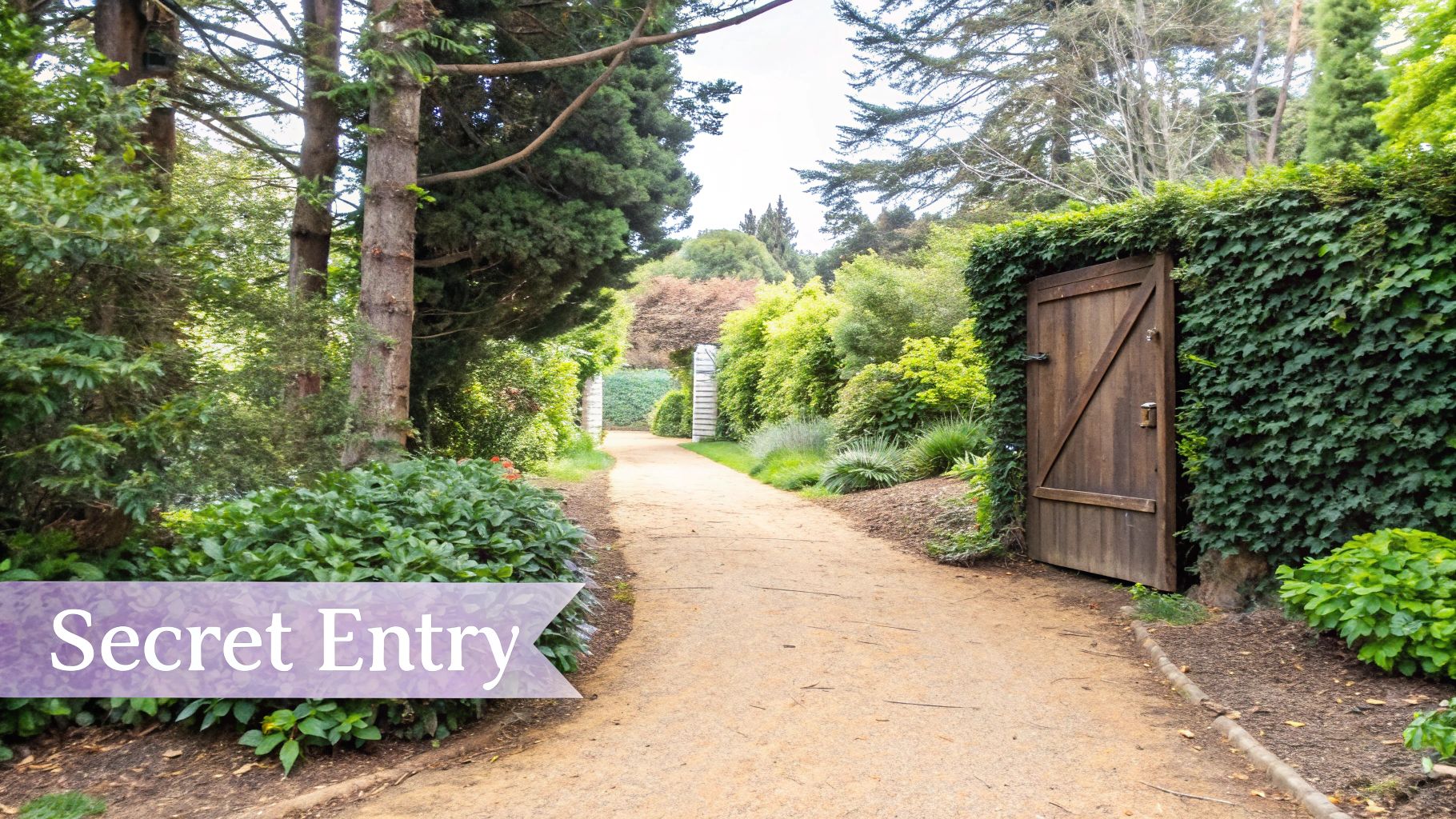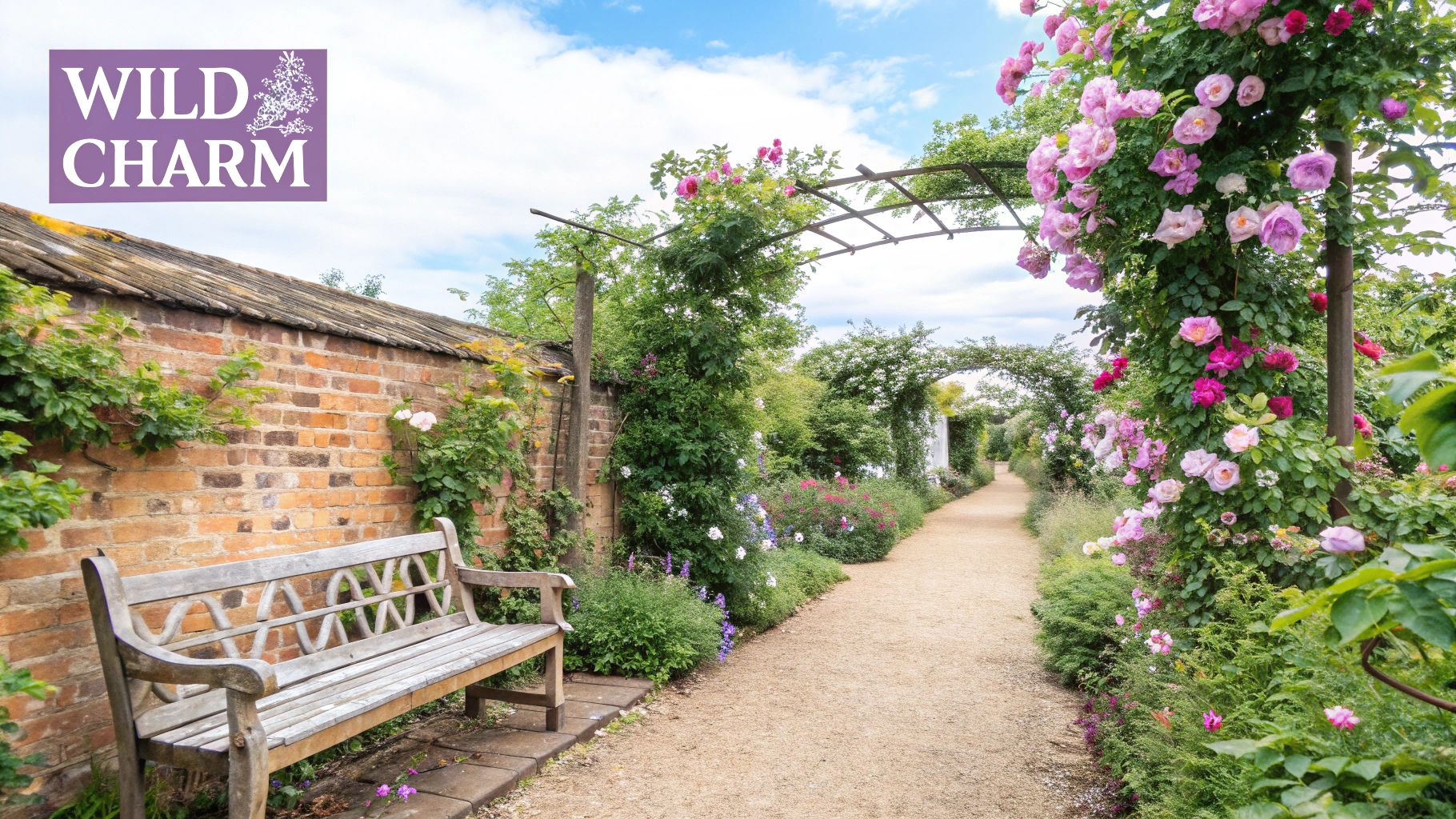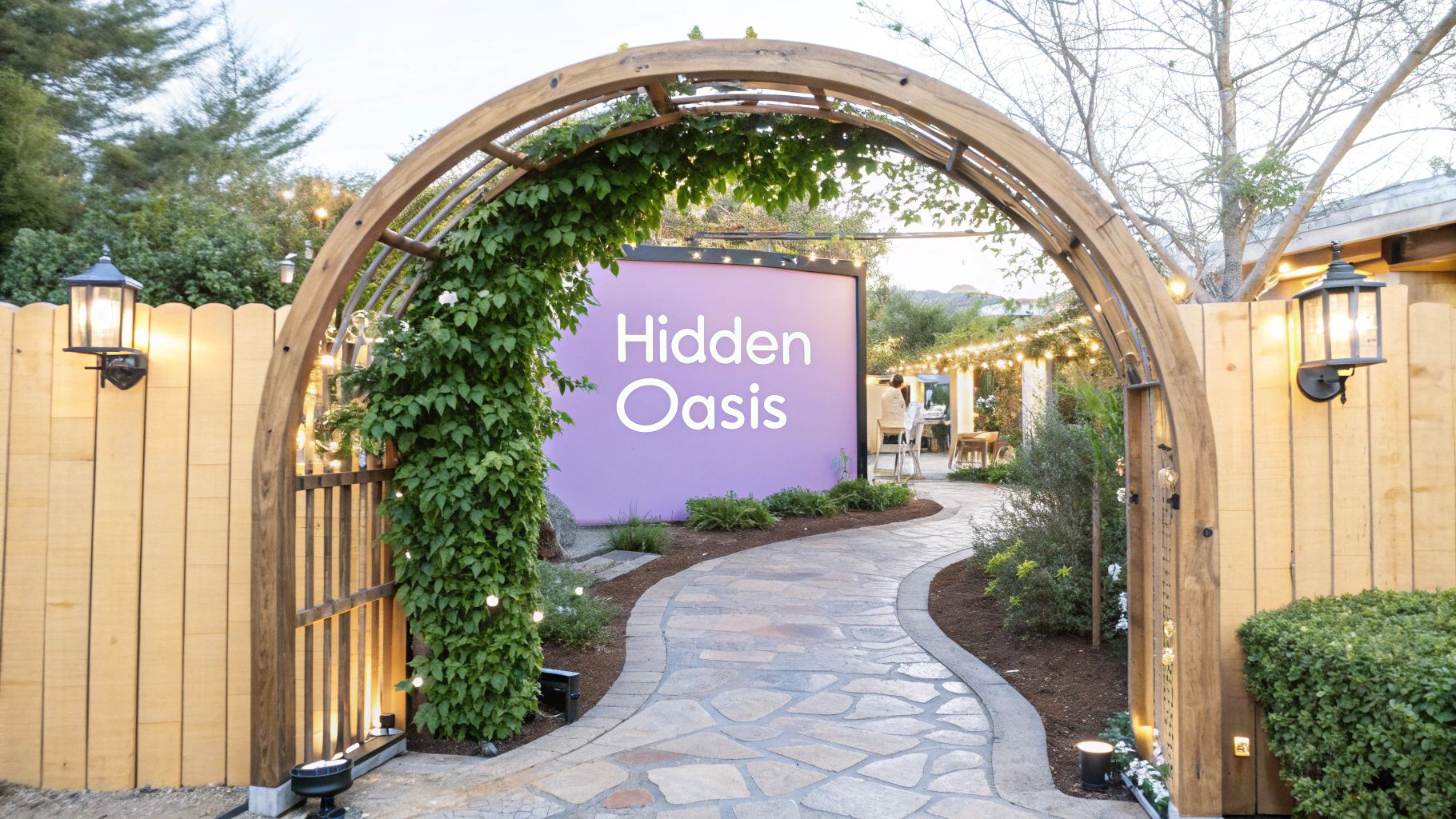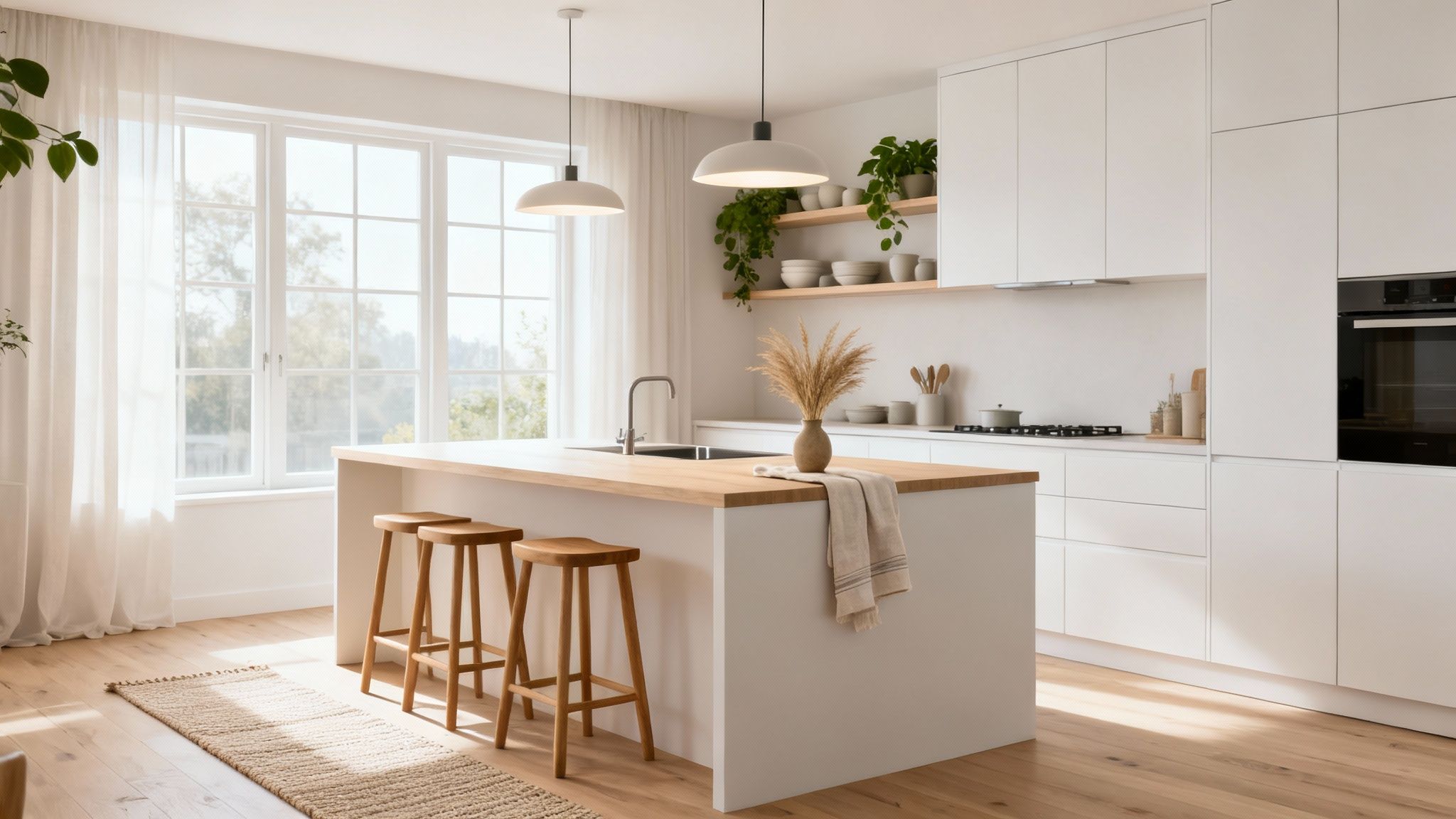Imagine stepping into a secluded corner of your own property, a world away from the everyday hustle. A secret garden isn't just a collection of plants; it's a personal sanctuary, a hidden retreat designed for peace, reflection, and quiet joy. Creating one is less about having acres of land and more about clever design, thoughtful planting, and a touch of mystery. It’s about crafting an experience, the thrill of discovery behind a hidden gate, the calm of a space enveloped by nature, or the charm of a seemingly wild, overgrown paradise.
This article explores seven distinct and inspiring secret garden ideas, moving beyond generic advice to provide you with practical, actionable plans. We'll delve into the specific layouts, plant choices, and decorative accents that define each unique style. You will find everything from the classic elegance of a walled sanctuary to the minimalist serenity of a Zen meditation space. Whether you have a sprawling lawn or a modest courtyard, you'll discover tangible strategies to transform it into the hidden oasis you've always dreamed of. Let's begin the journey to crafting your perfect private escape.
1. Walled Garden Sanctuary
The concept of a walled garden sanctuary is perhaps the most classic of all secret garden ideas, creating a true outdoor room that feels entirely separate from the world outside. This approach uses physical barriers, such as brick walls, stone fences, or dense, tall hedging, to establish a sense of privacy and intimacy. The result is a secluded retreat that not only offers psychological comfort but also creates a unique microclimate.
These defining structures protect tender plants from harsh winds and can trap the sun's warmth, allowing you to grow species that might not otherwise thrive in your climate. Popularised by iconic British garden designers like Vita Sackville-West at Sissinghurst Castle Garden and Lawrence Johnston at Hidcote Manor, this design transforms a simple patch of land into a series of enchanting, hidden spaces. The walls themselves become a vertical canvas for climbing plants, turning a functional boundary into a living tapestry of colour and scent.

How to Create Your Walled Sanctuary
Achieving this look is about more than just building walls; it requires careful planning to maximise both beauty and function.
- Material Harmony: Choose wall materials that echo the architectural style of your home. For example, pair a red brick house with reclaimed brick walls, or a Cotswold stone cottage with dry-stone walls for a cohesive, timeless feel.
- Vertical Planting: Soften the hard surfaces and add layers of interest with climbing plants. Fragrant options like star jasmine (Trachelospermum jasminoides) or classic climbing roses add sensory depth. For a productive twist, consider espaliered fruit trees like apples or pears, which grow flat against the wall.
- Sun and Shade Planning: Before finalising the layout, observe how sunlight moves across your garden. Position walls to deliberately create designated sunny spots for sun-loving plants and people, as well as cool, shady nooks for quiet contemplation or shade-tolerant species.
- Essential Practicalities: Ensure proper drainage at the base of any solid wall to prevent waterlogging, which can damage both the structure and plant roots. It's also wise to leave a small, accessible gap between the wall and your planting beds to make maintenance tasks like pruning and pest control much easier.
2. Hidden Entrance Garden
A hidden entrance garden elevates the concept of seclusion by focusing on the element of surprise and discovery. This approach uses clever design to obscure the access point, turning the simple act of entering the garden into a magical experience. Drawing inspiration from literary classics like Frances Hodgson Burnett's The Secret Garden, this idea transforms a simple gate or path into a delightful puzzle waiting to be solved.
The beauty of a hidden entrance lies in its ability to create a profound sense of separation and mystery. Instead of a clear gateway, the entrance might be a door disguised as part of a hedge, a gate covered in trailing ivy, or a pathway that appears to lead nowhere. This technique is masterfully employed in traditional Japanese gardens, which use the principle of miegakure (hide and reveal) to guide visitors along a journey of gradual discovery. Similarly, the walled courtyards of Spanish and Mediterranean architecture often feature unassuming doors that open into lush, private paradises.

How to Create Your Hidden Entrance
Crafting an entrance that feels both secret and accessible requires a blend of creative planting and practical design.
- Plant-Based Concealment: Use dense, evergreen shrubs or hedges like yew (Taxus baccata) or holly (Ilex aquifolium) to create a living wall that can hide a gate or doorway. For a softer look, train climbing plants such as ivy (Hedera helix) or Virginia creeper (Parthenocissus quinquefolia) over an arbour or gate to help it merge with the surrounding foliage.
- Architectural Disguise: Integrate the entrance into another garden feature. A "gate" could be a moveable section of a bookshelf in an outdoor library, a pivoting panel in a stone wall, or a door disguised to look like a tool shed. The key is to make the entrance functional but not visually obvious.
- Subtle Wayfinding: While the entrance should be hidden from casual observers, regular users need to find it easily. Use subtle cues like a uniquely shaped stepping stone, a specific type of ground cover plant, or a small, discreet lantern to mark the way without giving the secret away.
- Practical Considerations: Ensure any hidden mechanism, like a spring-loaded hinge or a sliding panel, is robust and regularly maintained to prevent it from jamming. It's also vital to consider emergency access and ensure the entrance remains usable and safe, with subtle lighting for evening accessibility.
3. Overgrown Cottage Garden Style
The overgrown cottage garden style is one of the most romantic and enchanting secret garden ideas, creating the feeling of a space that has been lovingly tended for generations. It embraces a deliberately wild, abundant look where plants spill over paths and jostle for position, giving the impression that nature has gently reclaimed a once-manicured plot. This style feels secret because it is full of surprises, with hidden corners and unexpected floral pairings that reveal themselves as you explore.
This approach was championed by horticultural visionaries like William Robinson, who advocated for "wild gardening," and later perfected by gardeners such as Christopher Lloyd at Great Dixter. It moves away from rigid formality, instead focusing on dense, layered plantings that create a rich tapestry of colour, texture, and form. The charm lies in its organised chaos; a seemingly untamed space that is, in fact, thoughtfully curated to look effortlessly natural and mysterious.

How to Cultivate the Overgrown Look
Mastering this style is a delicate balance between intentional design and allowing nature to take the lead. It's about creating a living, breathing space that feels both personal and timeless.
- Choose Self-Seeders and Weavers: Select plants that naturally spread and intermingle. Hardy geraniums, aquilegia, foxgloves (Digitalis purpurea), and Mexican fleabane (Erigeron karvinskianus) are excellent choices that will pop up in delightful, unplanned spots year after year.
- Maintain a Hidden Structure: While the goal is a "wild" look, a strong underlying structure is crucial. Use permanent features like winding gravel paths, rustic rose arches, or a weathered wooden bench to provide definition. Prune strategically to ensure dominant plants don't completely overwhelm their neighbours.
- Plan for Seasonal Succession: Ensure your secret garden holds interest all year by planning a continuous succession of blooms. Start with spring bulbs, move into a summer crescendo of roses and perennials, and finish with the rich colours of asters and Japanese anemones in autumn.
- Contrast Control with Chaos: The overgrown effect is most powerful when contrasted with a small area of neatness. A sharply edged lawn, a clipped box hedge, or a clean, tidy path can make the surrounding abundance feel even more magical and intentional.
4. Secluded Woodland Garden
A secluded woodland garden is one of the most enchanting secret garden ideas, designed to mimic the serene, dappled light and layered structure of a natural forest. This approach uses an overstorey of trees, a mid-layer of shrubs, and a ground cover of shade-loving perennials to create a cool, peaceful sanctuary. It feels worlds away from the hustle of urban or suburban life, offering a truly immersive escape into nature.
This style was pioneered by visionaries like Henry Francis du Pont at Winterthur Garden and landscape architect Jens Jensen, who championed the use of native plants to create sustainable, harmonious ecosystems. The design leverages existing shade or strategically plants trees to establish a canopy, under which a rich tapestry of textures and quiet colours can unfold. It's a living garden that evolves with the seasons, from the first spring bulbs to the rich colours of autumn leaves.

How to Create Your Woodland Garden
Building a woodland retreat is about cultivating a naturalistic, layered environment that thrives in lower light conditions.
- Embrace Native Species: Start with a foundation of native trees and shrubs like birch, rowan, or hazel. These are already adapted to your local climate and soil, making them low-maintenance and beneficial for local wildlife.
- Layer Your Plantings: Replicate a forest floor by layering plants according to height. After establishing your tree canopy (overstorey), add shade-tolerant shrubs like hydrangeas or rhododendrons (mid-storey), followed by perennials like hostas, ferns, and hellebores (ground cover).
- Introduce Seasonal Surprises: Weave in drifts of spring-flowering bulbs such as snowdrops, bluebells, and wild daffodils (Narcissus pseudonarcissus). They will naturalise over time, creating a magical carpet of colour before the tree canopy fully leafs out.
- Create a Destination: Design winding, informal paths using natural materials like bark chippings or stepping stones. Place a simple bench or a pair of chairs in a small clearing to create an inviting destination for quiet reflection within your secret garden.
5. Keyhole Garden Layout
Originally conceived for sustainable food production in dry African climates, the keyhole garden layout is a brilliantly functional and visually captivating secret garden idea. This design features a raised, circular garden bed with a pie-slice cutout leading to a central composting basket. This clever structure not only creates an intimate, enclosed planting area but also provides a self-fertilising, water-efficient system that nourishes the garden from its core.
When adapted for an ornamental or mixed-use secret garden, the keyhole layout fosters a unique sense of discovery. The path invites you into the heart of the planting, surrounding you with foliage and flowers. Its distinct shape, popularised by the permaculture movement and urban farming initiatives, transforms a small space into a productive and private sanctuary. The raised edges provide a clear boundary, while the central access point makes tending to plants an immersive, hands-on experience.
How to Create Your Keyhole Layout
Building a keyhole garden is a rewarding project that blends resourceful construction with smart planting design.
- Resourceful Construction: Use local or reclaimed materials like stone, bricks, or even logs to build the retaining walls of the circular bed. This not only reduces cost but also helps the garden blend seamlessly with its natural surroundings. The central compost basket can be made from simple wire mesh or wicker.
- Strategic Plant Placement: Arrange plants according to their mature height and water needs. Place taller plants, like sunflowers or ornamental grasses, at the back (furthest from the path) to create a green wall effect. Position thirsty plants closer to the central compost basket, where moisture and nutrients are most concentrated.
- Composting Best Practices: Maintain a healthy balance in your central basket by adding a mix of "greens" (kitchen scraps, fresh grass clippings) and "browns" (dried leaves, cardboard, straw). This ensures the compost breaks down efficiently, releasing a steady supply of nutrients into the soil.
- Incorporate Perennials: While excellent for annual vegetables and flowers, including perennial plants like herbs, hostas, or compact shrubs provides year-round structure and interest. This ensures your secret garden doesn't look bare during the off-season and reduces your yearly planting workload.
6. Maze or Labyrinth Garden
A maze or labyrinth garden is one of the most playful and engaging secret garden ideas, transforming the journey into an adventure in itself. This design uses structured pathways, defined by hedges, low walls, or even tall grasses, to create a puzzle that leads to a hidden central destination. It evokes a sense of historical grandeur and mystique, encouraging exploration and creating a profound sense of arrival when the secret space is finally discovered.
The concept has deep roots, popularised by European royal garden designers and Renaissance Italian architects who saw gardens as a form of art and entertainment. Famous examples like the Hampton Court Palace maze and the modern labyrinth at the Getty Centre showcase how this idea can be adapted to both classical and contemporary settings. The very act of navigating the paths disconnects you from the everyday, making the secluded central feature-be it a bench, a sculpture, or a quiet pond-feel even more rewarding.
How to Create Your Maze or Labyrinth
Designing a labyrinth requires careful planning to ensure it is both intriguing and manageable, turning a simple walk into a memorable experience.
- Choose the Right Plants: For classic maze walls, opt for slow-growing, dense evergreen hedging like yew (Taxus baccata) or box (Buxus sempervirens). These require less frequent trimming and maintain their structure year-round. For a softer, more informal feel, consider ornamental grasses or perennial borders.
- Plan for Maintenance: A key practical consideration is access. Design your pathways to be wide enough for a wheelbarrow or mower. It is also wise to incorporate discreet access points within the design to simplify tasks like weeding, pruning, and tending to the central feature without having to navigate the entire maze each time.
- Introduce Height Variation: Create a more dynamic and visually interesting journey by varying the height of your "walls." Start with lower hedges at the entrance and gradually increase their height as visitors move towards the centre. This technique enhances the sense of enclosure and mystery.
- Safety and Navigation: For more complex mazes, consider including subtle emergency exit routes or a "map" at the entrance for younger visitors. The goal is joyful discovery, not genuine frustration. A simple, single-path labyrinth offers a more meditative experience, while a branching maze provides a fun challenge.
7. Zen Meditation Garden
A Zen meditation garden is one of the most profound secret garden ideas, creating a tranquil space designed for peace and contemplation. Rooted in Japanese tradition, this style uses minimalist principles, natural materials, and carefully selected plants to craft an environment that quiets the mind. The focus is not on floral abundance but on creating a serene, harmonious landscape that encourages mindfulness and reflection through its simplicity.
This approach transforms a garden into a place of sanctuary, where every element has a purpose. The careful arrangement of rocks, sand, water features, and restrained planting is meant to evoke a feeling of natural stillness. The style was perfected by traditional Japanese garden masters at temples like Ryoan-ji in Kyoto and has been beautifully adapted worldwide, from the Portland Japanese Garden in Oregon to modern residential gardens. Its emphasis on uncluttered space and natural beauty makes it a powerful tool for creating a truly private mental escape.
How to Create Your Zen Garden
Designing a Zen garden is an exercise in intentionality, where less is truly more. Success lies in the thoughtful placement of each component.
- Mindful Material Selection: Use natural, local materials wherever possible. Incorporate elements representing nature: stones for mountains, raked sand or fine gravel for water, and moss for ancient forests. The goal is to create a miniaturised, idealised landscape.
- Focus on Form and Texture: Choose plants for their structure and foliage rather than bright colours. Japanese maples (Acer palmatum) offer graceful forms, while mosses, ferns, and mondo grass provide lush, green texture. Bamboos can be used for screening but choose a clumping variety to prevent invasive spreading.
- Create a Focal Point: A single, striking element can anchor the entire design. This could be a stone water basin (a tsukubai), a sculptural rock, or a simple stone lantern. This focal point gives the eye a place to rest and aids contemplation.
- Embrace Asymmetry and Space: A key principle of Zen design is fukinsei (asymmetry), which feels more natural and balanced than perfect symmetry. Equally important is ma (negative space). Leave areas open and uncluttered to give each element room to be appreciated and to create a sense of calm.
Secret Garden Ideas Comparison Table
Your Sanctuary Awaits: Bringing Your Secret Garden to Life
We have explored a tapestry of enchanting secret garden ideas, each offering a unique blueprint for creating a personal sanctuary. From the formal, protective embrace of a Walled Garden to the wild, untamed romance of an Overgrown Cottage Style, the core concept remains the same: crafting a space that is intentionally hidden, deeply personal, and restorative to the soul. Whether you were drawn to the clever design of a Keyhole Garden or the meditative calm of a Zen Garden, these concepts are not rigid prescriptions but rather sources of inspiration. The true magic lies in blending these elements to reflect your own personality and the unique character of your outdoor space.
The journey to your own hidden oasis begins not with a shovel, but with a vision. The most crucial takeaway is that a secret garden is defined by its feeling of seclusion and discovery, not by its size or complexity. You can cultivate this atmosphere in a sprawling country estate or a modest urban courtyard. The key is to weave together the three foundational pillars we have discussed: enclosure, pathway, and destination. By mastering these, you can transform any corner into a secluded retreat.
Your Actionable Next Steps
To move from inspiration to implementation, consider these practical starting points:
- Assess and Select: Revisit the seven secret garden ideas and identify which one truly resonates with your lifestyle and available space. Are you seeking a productive, organised haven like a Keyhole Garden, or a low-maintenance, contemplative space like a Secluded Woodland Garden? Choose the concept that sparks the most joy.
- Start Small: Do not feel pressured to execute a grand design all at once. Begin with a single, manageable element. This could be creating a Hidden Entrance with a simple arched trellis and a fast-growing climber like clematis, or establishing a small cluster of shade-loving plants to evoke a woodland feel.
- Layer Over Time: A garden is a living, evolving entity. Think of it as a long-term project. Add features incrementally, perhaps introducing a water feature one season and a secluded seating area the next. This patient approach allows your garden to grow with you, becoming richer and more personal each year.
Ultimately, the value of creating a secret garden extends far beyond simple aesthetics. It is an investment in your well-being, a commitment to carving out a private world where you can disconnect from daily pressures and reconnect with the rhythms of nature. By taking these initial steps, you are not just planting flowers or laying stones; you are cultivating a cherished sanctuary, a hidden gem that is uniquely and wonderfully yours. Your personal haven is waiting to be realised.




